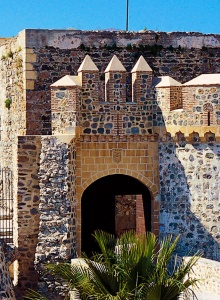The Granada coast, on the shore of the Mediterranean, has one of the oldest towns on the so-called Tropical Coast.
Of Phoenician origin, the former Sexi brings together a rich archaeological and monumental heritage with excellent beaches suitable for swimming, diving and a wide variety of water sports. Its cuisine, centred on Mediterranean fish and seafood, leads us to other nearby places, like, for example,Granada. The Alhambra, the Generalife and the district of Albaicín, declared World Heritage Sites, are among its treasures.
Between the sea and the mountains, the municipality of Almuñécar offers visitors a great variety of beaches and coves spread along 20 kilometres of coast. Shallow water, ideal for children, at Calabajío; the opportunity to practise naturism at the bottom of a ravine in Cantarrijan, lively nights in Puerta del Mar or marine depths to go diving in La Herradura are some of the opportunities offered by this part of the Costa Tropical. Development in the area has created large summer holiday developments while still caring for the natural environment, So, visitors can enjoy all the charms of the landscape and the most varied range of leisure activities.But Almuñécar also has a long history, going back to the year 800 BC., a date when it was founded by the Phoenicians as a trading colony. From this period you can visit a necropolis and a salting works. In their Manaba Sexi Firman, the Romans left an aqueduct and some baths on the outskirts of the city and the Cueva de Siete Palacios. Under these Roman vaults, the Almuñécar Archaeological Museum has been established, where you can admire pieces found on nearby sites. The strategic location of this place was appreciated by the Muslims, who provided its town centre with walls and a castle, that of San Miguel. In fact, the surrounding district preserves the irregular layout typical of this kind of medieval development. Cobbled streets and whitewashed façades are the distinctive features of this area, where the visitor will find courtyards full of flowers and unforgettable corners. On some of Almuñecar's beaches, old watchtowers, also from the Muslim period, await you. They also served for warding off attacks by Berbers and pirates. An example is the one that stands on the beach at Tesorillo.Almuñécar was not reconquered by the Catholic Monarchs until 1489. Important Spanish Renaissance architects and sculptors contributed to building the Church of La Encarnación, an example of a Christian place of worship. Designed by Juan de Herrera, Felipe II's architect, it has a tower which is the work of Diego de Siloé. Another Renaissance-style monument is the Pilar de la Calle Real. This is a group of sculptures made over an old Roman water channel. To find out something more about Almuñeécar, it is worth visiting the City History Museum in the Castle of San Miguel, where you will find interesting collections. The Castle of La Herradura, ordered to be built by Carlos III, is another of the symbolic buildings of this city in the province of Granada.And, as for the county's cuisine, fish take a clear leading role in the local recipes."Arroz a banda" (a variety of paella), fried fish, skewered sardines, langoustines, hake, and fish and shellfish casserole are just some of the recommendations. Among meats, kid with garlic accompanied by potatoes has the greatest tradition. As well as the tropical fruits grown in this excellent climate, visitors should try "cazuela mohina" or "cazuela de San Juan". It is a dessert of Arab origin similar to marzipan which is eaten in small portions. The main ingredients are almonds, sugar, aniseed and pumpkin. The surroundings of Almuñécar offer us interesting summer holiday places like Nerja (with Parador de Turismo), Motril (excellent beaches and golf courses) or Adra, which also has a Phoenician origin. Right in the Granada Alpujarras, the Spa at Lanjarón offers its medicinal waters to anyone who wants to relax there for a few days. Nearby are the more than 3,000 metre high summits of the Sierra Nevada and its National Park. A multitude of routes cross this protected area, while the natural park has a ski station open throughout the snow season. Also awaiting you is the provincial capital, Granada. Its Arab flavour is palpable in the palaces and buildings of the Alhambra, the Generalife and the Albaicín district, all declared a World Heritage Site by UNESCO.








